INTRODUCTION
Teeth are very important not only to perform the various functions but they also maintain the profile of patient and preserve the alveolar bone. Loss of teeth leads to resorption of the alveolar process and decrease in the alveolar bone length and volume.1-4 Bone is the foundation of support for the prosthesis, a multitude of factors affect bone however none more than the teeth.5, 6 The basic function of maxillary and mandibular arches is to support teeth; thus when teeth are lost, bone is lost.7, 8 Telescope Dentures, Overly Dentures, Hybrid dentures, Overdentures are some of the synonym names used to describe tooth supported/assisted overdentures. Studies have shown that removal of teeth and wearing of complete denture generally results in loss of alveolar bone. Tallgren found bone loss is four times more common in mandible than maxilla over a period of 7 years.9, 10
To overcome the increased loss of alveolar bone in partially edentulous areas, natural teeth can be used as an additional support for the prosthesis. Ledger encouraged leaving “Stumps” under artificial teeth. Tooth supported overdentures should be considered in every cases as an alternative to extraction of all natural teeth and they may be used instead of restorative procedures, such as fixed or removable partial dentures.11 Preserved and prepared root stumps for conventional overdentures add to the benefits of the complete denture. Retention of natural teeth for overdentures preserves some of the sensory input from periodontal receptors which are more precise than that obtained from the oral mucosa and the Sensory innervations is important components of mastication. Tooth mobility is also reduced when the tooth was preserved and reduced in height; the mobility was reduced from 100 to 60%. Overdentures patients had shown better chewing efficiency (1/3 higher) than the complete denture patient and the most important reason to preserve the tooth is that it ultimately preserves the alveolar bone heath and volume.12, 13
Case Report 1
A 60 year old man reported with the chief complaint of difficulty in mastication, on clinical examination revealed presence of few remaining maxillary and mandibular teeth. Teeth present in the upper arch were 16, 21, 24, 26 and in the lower arch the teeth present were 33, 34 (Figure 1). The teeth present in the said case can adjunct retention by providing triangular support to the prosthesis (Figure 2). During treatment planning it was decided to preserve all the remaining natural teeth and prepare them as abutments for the denture to make a conventional overdenture which will add to the retention, stability & support of the prosthesis. Diagnostic casts were prepared and were mounted, which made known adequate clearance of the teeth. Treatment planning was decided and was explained to the patient who wanted not to get extracted any more teeth and the patients consent was taken into consideration which included first endodontic preparation of the teeth followed by Prosthodontic rehabilitation.
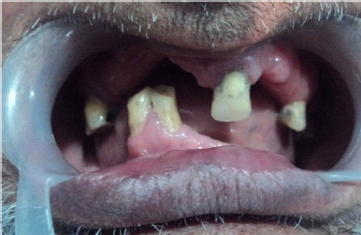
|
Figure 1: Partially Edentulous Patient
Click here to view |
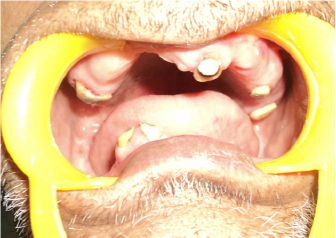
|
Figure 2: Triangular support of Abutments
Click here to view |
In the first phase all the remaining natural teeth were endodontically treated and amalgam plugs were placed over the obturated canals to seal the canals. After endodontic treatment teeth crowns were reduced in the height 1mm above the gingival height.
The Prosthodontic rehabilitation of the patient was initiated by making primary impression with irreversible hydrocolloid impression material. Wash impression was made with vinyl silicone. Jaw relation was recorded and teeth arrangement was done keeping in consideration the position of abutment teeth. Followed by try in of the patient and processing of the denture. The overdenture was checked for occlusion within the oral cavity (Figure 3).14 Overdenture was delivered to the patient (Figure 4) and the denture had increased retention, stability and support.
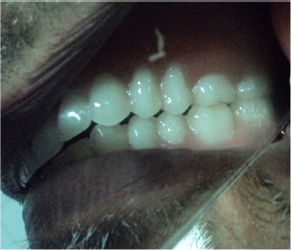
|
Figure 3: Checking Occlusion
Click here to view |
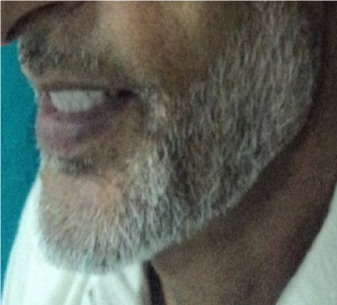
|
Figure 4: Post- Insertion
Click here to view |
Case Report 2
A 57 year old male reported with the chief complaint of inability to chew. On clinical examination it was found that his teeth were missing from upper right and left posterior side and lower two central incisors were missing. The upper arch has present only four teeth comprising of two central incisors lateral and canine of left side (Figure 5). The patient wanted to preserve the remaining upper teeth so it was decided to make overdenture over the remaining teeth of upper arch. The treatment procedure was well explained to the patient in advance comprising of endodontic and Prosthodontic rehabilitation.
Teeth were first treated endontically this was followed by preparation of the abutments to place copings over them. Metal coping were placed over the prepared teeth to decrease the influences of caries attack on the remaining reduced tooth structure (Figure 6).15 The denture was constructed in conventional manner keeping in view the prominence of abutments. Overdenture abutments were relieved by hollowing the acrylic resin teeth with acrylic bur until the teeth were properly positioned over the abutments and occlusion checked. During try - in appointment the following things were taken into consideration16
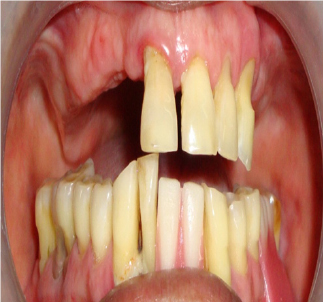
|
Figure 5: Retained Teeth
Click here to view |
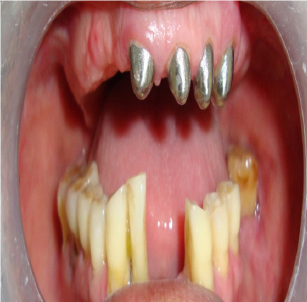
|
Figure 6: Metal Coping Abutments
Click here to view |
-
1- Jaw Relation record were verified
-
2- Aesthetic were checked
-
3- Phonetic Verified
After try in, the denture was processed, polished and finished. The processed denture was delivered to the patient that showed increased retention and stability (Figure 7).
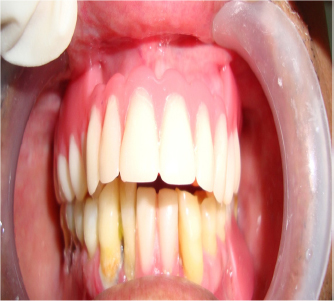
|
Figure 7: Overdenture Insertion
Click here to view |
Case Report 3
A 60 year male with chief complaint of inability to chew and aesthetic deficiency .On clinical examination it was found that maxillary arch was completely edentulous and only one tooth was present in the mandibular arch per quadrant. The tooth present were 34, 44 in the mandibular arch (Figure 8). The benefit of retaining the remaining two natural teeth in the mandibular arch were explained to the patient and treatment plan was according decided in consent with the patient. So an overdenture was decided for the mandibular arch and a conventional denture for the maxillary arch was planned.
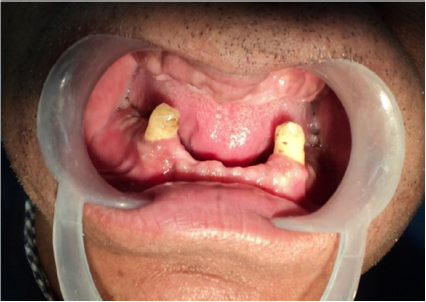
|
Figure 8: Retained Teeth
Click here to view |
Treatment plan consist of endodontic procedure followed by prosthetic rehabilitation. Endodontic treatment was completed followed by reducing up to 1mm above the gingival height and measuring the post length while leaving 3-4mm of apical Gutta Percha in the canal. Gutta Percha was removed with pesos reamers. Primary reamer was used o prepare the full length of post followed by preparing the countersink drill to create the flange and second tier preparation. Trail of the access post EDS (Essential Dental System) was done to ensure proper fit of the post. The post space created canal was etched and resin cement was used for luting the EDS post within the canal, excess cement if any was removed.
This was followed by prosthetic rehabilitation of the patient. Primary and wash impression of both the arches was made followed by Jaw relation and try in. A well polished processed denture was prepared for insertion. Rubber bands were positioned to cover the height of contour of the post ball (Figure 9). The nylon female caps were placed on globe of post. Marking paste was placed on the cap and denture inserted over the ball post. Denture was removed, relieved in the area of marking paste to make space for nylon cap. Pink cold cure acrylic resin was placed in the relieved area. Denture was seated in the oral cavity and patient was instructed to close in centric occlusion. This was followed by removing the denture along with pick up attachment cap present on the inner surface of denture. The rubber band was removed and the excess if any was trimmed and inserted to the patient (Figure 10).
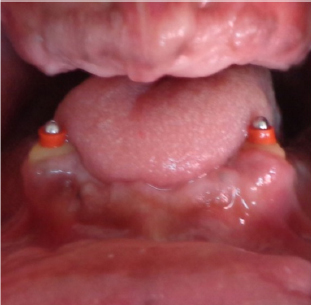
|
Figure 9: Rubber band on Post
Click here to view |
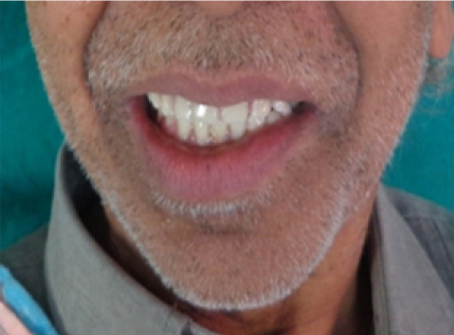
|
Figure 10: Post Insertion
Click here to view |
The access post retained denture not only helps in achieving the primary goals of an overdenture, besides, it acts as passive post that provides necessary strength, retention and stability a restoration requires. As the name says, it also gives access to the periapical tissues and ability to retreat if they get infected post-treatment, providing a much predictable overdenture treatment option.
CONCLUSION
Modern techniques of preventive dentistry allow the dentist to restore and retain virtually all natural teeth to serve as prosthetic abutments. Overdenture is a preventive dentistry concept which has been brought into prosthodontics.17, 18
In partially edentulous patient it is utmost important to preserve the remaining natural teeth as they have direct influence on the ridge.19 It has been found that overdenture patients have chewing efficiency 1/3 higher than complete denture patients.20 Partially edentulous patients have the feeling of proprioception through the remaining teeth even the presence of few natural teeth has strong psychological values for some patients. The overdenture abutments minimize the horizontal torquing forces on the denture and improve the stability and retention of denture. Retained overdenture abutments inhibit the rapid loss of alveolar bone. The prognosis of the restoration is likely to be influenced by numerous factors like Selection of patient, Treatment planning,
Preparation of mouth, Execution of Prosthodontic work and maintenance
Finally it is reasonable to conclude that the retention of a part of the natural dentition offer the overdenture patient a gain in neuromuscular performance thereby giving him an edge over his edentulous counterpart
